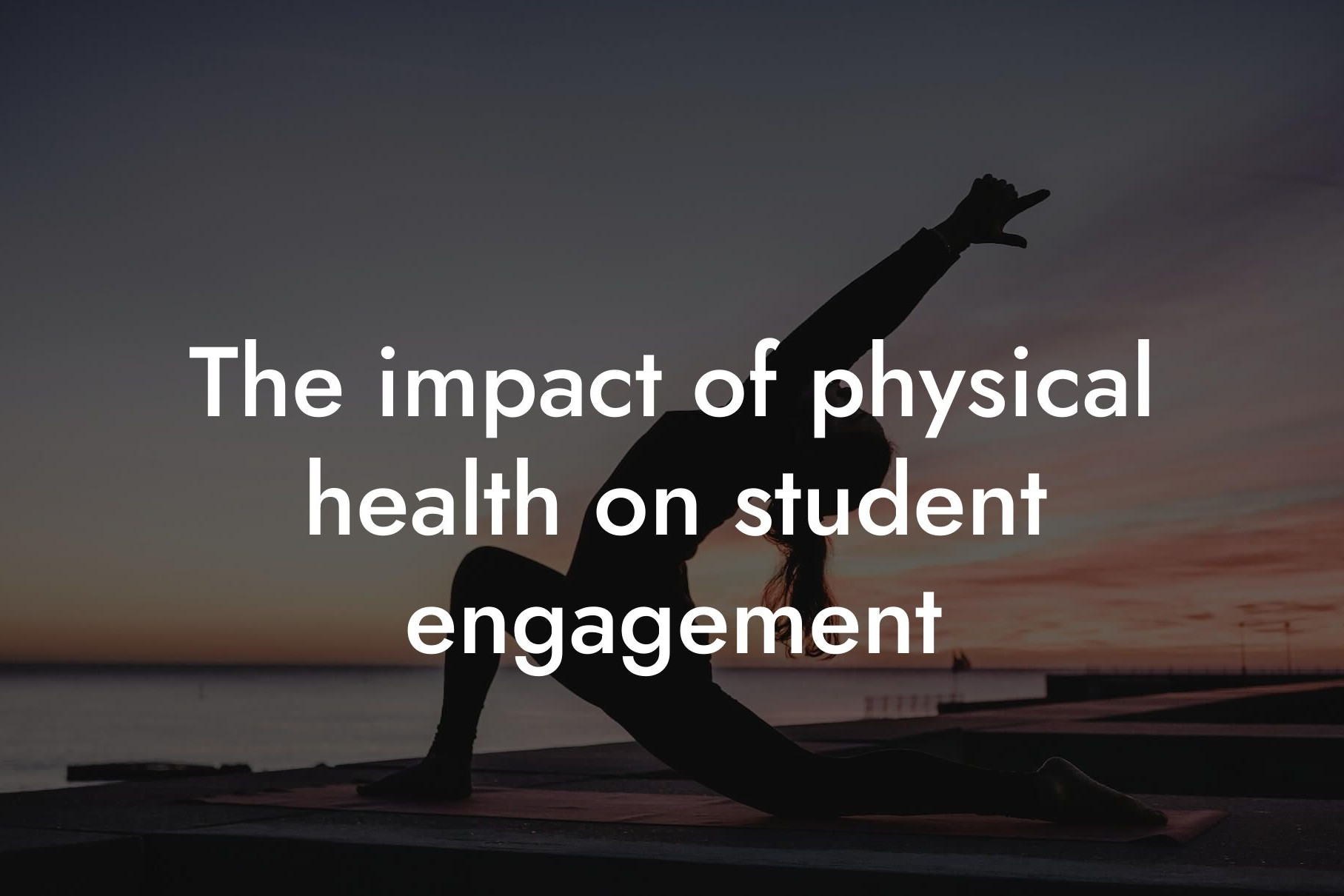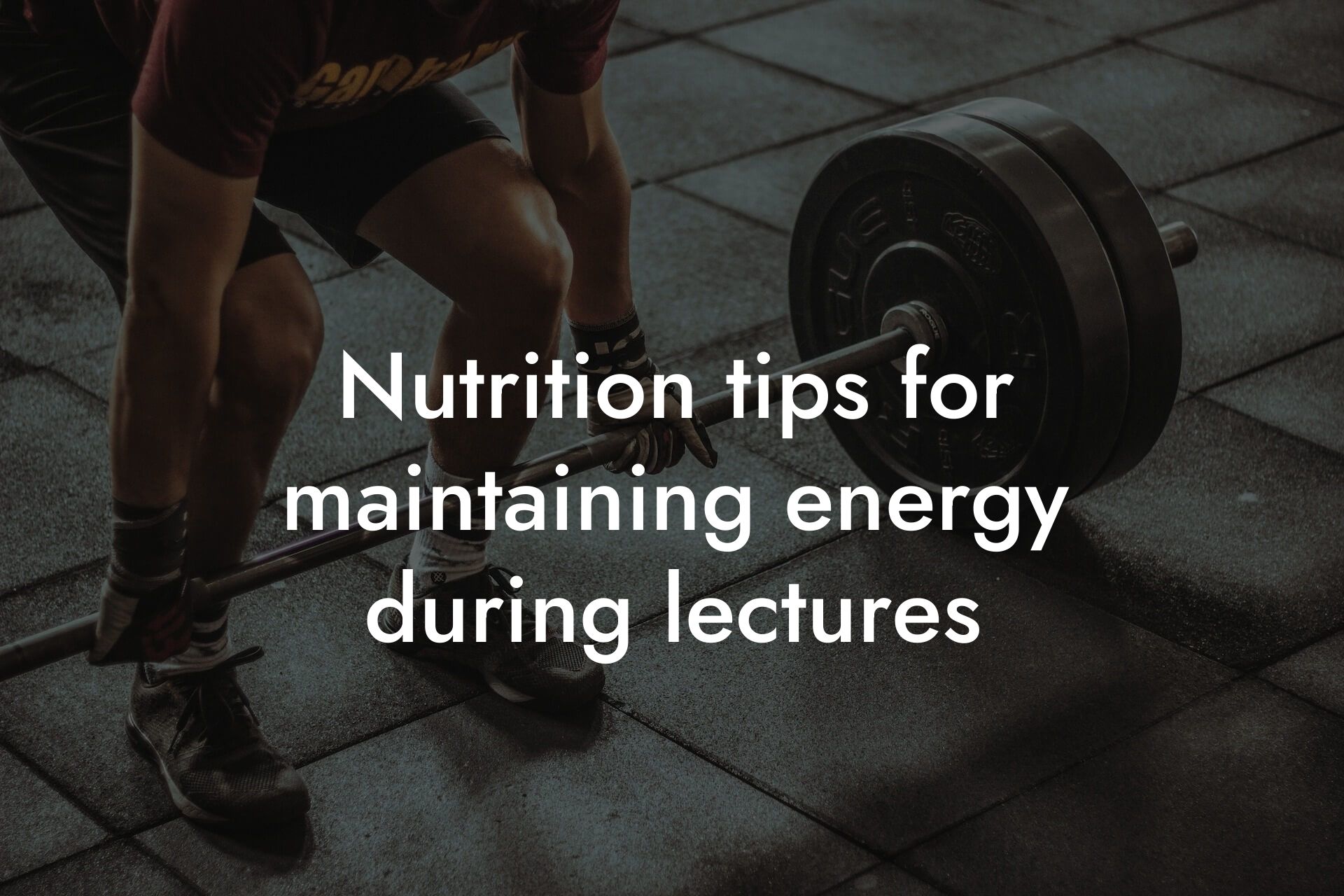As an educator, you know that teaching is a demanding profession that requires a lot of energy, patience, and dedication. Long teaching days can be exhausting, both physically and mentally, making it challenging to prioritize your fitness goals. However, it's essential to remember that taking care of your physical health is crucial to maintaining your overall well-being and performing at your best in the classroom. In this article, we'll provide you with practical tips and strategies on how to stay fit during long teaching days.
Table of Contents
- Understand the Challenges of Teaching
- Start Your Day with a Morning Routine
- Take Breaks and Move Throughout the Day
- Stay Hydrated and Fuel Your Body
- Incorporate Physical Activity into Your Lesson Plans
- Use Your Lunch Break Wisely
- Make Time for Self-Care
- Monitor Your Progress and Set Realistic Goals
- Get Support from Colleagues and Friends
- Frequently Asked Questions
Understand the Challenges of Teaching
Teaching is a high-stress profession that can take a toll on your physical and mental health. Long hours of standing, grading papers, and managing classroom behavior can lead to fatigue, back pain, and other musculoskeletal issues. Additionally, the pressure to meet curriculum requirements, manage classroom dynamics, and deal with parental expectations can cause significant stress and anxiety. It's essential to acknowledge these challenges and prioritize your health to avoid burnout.
Start Your Day with a Morning Routine
Begin your day with a morning routine that sets the tone for a healthy and productive day. This can include a 10-15 minute workout, such as yoga, stretching, or a brisk walk. You can also incorporate meditation, journaling, or reading to help you relax and focus. A morning routine helps increase your energy levels, improves your mood, and prepares you for the demands of the day.
Take Breaks and Move Throughout the Day
As an educator, you're likely to spend most of your day sitting or standing in one place. It's essential to take breaks and move throughout the day to reduce the risk of chronic diseases, such as heart disease, diabetes, and obesity. Take a 5-10 minute break every hour to stretch, walk around the room, or do a few jumping jacks. You can also incorporate desk exercises, such as chair squats, desk push-ups, or leg raises, to keep your muscles active.
Stay Hydrated and Fuel Your Body
Drinking plenty of water throughout the day is crucial to maintaining your energy levels and focus. Aim to drink at least 8-10 glasses of water per day, and avoid sugary drinks that can lead to energy crashes and decreased productivity. Additionally, fuel your body with nutritious meals and snacks that include lean proteins, complex carbohydrates, and healthy fats. Avoid relying on caffeine and sugary snacks that can provide temporary energy boosts but lead to energy crashes later.
Incorporate Physical Activity into Your Lesson Plans
Incorporating physical activity into your lesson plans can help you stay active while engaging your students in fun and interactive learning experiences. For example, you can incorporate movement-based activities, such as jumping jacks or dance breaks, into your lessons to help students release energy and focus. You can also incorporate outdoor activities, such as nature walks or scavenger hunts, to provide students with hands-on learning experiences.
Use Your Lunch Break Wisely
Your lunch break is an excellent opportunity to prioritize your fitness goals. Use this time to take a walk, do a quick workout, or practice yoga or meditation. You can also use this time to prepare healthy meals or snacks for the rest of the day. Avoid using your lunch break to scroll through social media or watch TV, as this can lead to decreased productivity and energy crashes.
Make Time for Self-Care
As an educator, you're likely to prioritize your students' needs over your own. However, it's essential to make time for self-care to avoid burnout and maintain your overall well-being. Schedule time for activities that bring you joy and relaxation, such as reading, listening to music, or spending time with loved ones. You can also prioritize activities that promote physical relaxation, such as getting a massage, taking a warm bath, or practicing yoga or meditation.
Monitor Your Progress and Set Realistic Goals
Monitoring your progress and setting realistic goals is crucial to staying motivated and achieving your fitness goals. Use a fitness tracker or mobile app to track your physical activity, sleep patterns, and nutrition. Set specific, measurable, and achievable goals, such as increasing your step count or reducing your body fat percentage. Celebrate your successes and adjust your goals as needed to stay motivated and focused.
Get Support from Colleagues and Friends
Staying fit during long teaching days can be challenging, but it's easier with the support of colleagues and friends. Join a fitness group or find a workout buddy to provide motivation and accountability. Share your fitness goals and progress with colleagues and friends to get support and encouragement. You can also participate in school-sponsored wellness programs or fitness initiatives to connect with like-minded educators.
Staying fit during long teaching days requires commitment, discipline, and creativity. By incorporating physical activity into your daily routine, prioritizing self-care, and making healthy lifestyle choices, you can maintain your overall well-being and perform at your best in the classroom. Remember to start small, set realistic goals, and celebrate your successes along the way. With the right mindset and strategies, you can stay fit, focused, and energized throughout the school year.
Frequently Asked Questions
What are the physical demands of teaching, and how can they impact my fitness?
Teaching is a physically demanding profession that requires standing for long periods, moving around the classroom, and engaging in energetic activities with students. Prolonged standing, heavy lifting, and bending can lead to fatigue, musculoskeletal injuries, and decreased physical fitness. Additionally, the high-stress environment of teaching can also contribute to weight gain, decreased motivation, and poor overall health.
Why is it essential for educators to prioritize their physical fitness?
Prioritizing physical fitness is crucial for educators as it directly impacts their energy levels, focus, and overall well-being. Regular exercise can help reduce stress, improve mood, and increase productivity, ultimately leading to better teaching performance and a more positive learning environment for students.
What are some common challenges educators face in maintaining a fitness routine?
Common challenges educators face in maintaining a fitness routine include lack of time, energy, and motivation. Long teaching days, grading, and lesson planning can leave little time for exercise, and the physical and mental demands of teaching can make it difficult to muster the energy to engage in physical activity.
How can I fit exercise into my busy teaching schedule?
To fit exercise into your busy teaching schedule, try breaking it down into smaller, manageable chunks, such as taking a 10-minute walk during your lunch break or doing a quick 20-minute workout at home before or after school. You can also consider scheduling exercise into your daily planner or calendar to ensure it becomes a priority.
What are some simple exercises I can do at my desk or in the classroom?
Simple exercises you can do at your desk or in the classroom include chair squats, desk push-ups, leg raises, and arm circles. You can also try taking a few deep breaths, stretching your arms overhead, or doing some shoulder rolls to reduce tension and increase energy.
How can I stay hydrated during long teaching days?
To stay hydrated during long teaching days, make sure to drink plenty of water throughout the day. Aim to drink at least 8-10 glasses of water, and avoid sugary drinks and caffeine that can lead to dehydration. You can also consider keeping a refillable water bottle at your desk or in the classroom as a reminder to drink regularly.
What are some healthy snack options for busy educators?
Healthy snack options for busy educators include nuts, fruits, carrot sticks with hummus, energy bars, and trail mix. Aim for snacks that are high in protein, fiber, and complex carbohydrates to provide sustained energy and support overall health.
How can I prioritize self-care and reduce stress as an educator?
To prioritize self-care and reduce stress as an educator, make time for activities that bring you joy and relaxation, such as reading, taking a warm bath, or practicing yoga or meditation. You can also consider setting boundaries, delegating tasks, and seeking support from colleagues or a mental health professional when needed.
What are some tips for getting enough sleep as an educator?
Tips for getting enough sleep as an educator include establishing a consistent bedtime routine, avoiding caffeine and electronics before bedtime, and creating a relaxing sleep environment. Aim for 7-9 hours of sleep each night to help your body and mind recharge for the next day.
How can I stay motivated to exercise and prioritize my fitness?
To stay motivated to exercise and prioritize your fitness, set specific, achievable goals, and find an exercise buddy or accountability partner to provide support and encouragement. You can also consider tracking your progress, rewarding yourself for milestones achieved, and celebrating small victories along the way.
What are some fitness apps or online resources that can support educators in their fitness journey?
Fitness apps and online resources that can support educators in their fitness journey include Nike Training Club, Fitbit, and Peloton Digital. These resources offer a variety of workouts, tracking features, and community support to help educators stay motivated and accountable.
How can I incorporate physical activity into my lesson plans and engage my students in fitness?
To incorporate physical activity into your lesson plans and engage your students in fitness, try incorporating movement-based learning activities, such as brain breaks, dance parties, or outdoor games. You can also consider partnering with a physical education teacher or fitness professional to develop fitness-focused lesson plans.
What are some common myths about exercise and fitness that educators should be aware of?
Common myths about exercise and fitness that educators should be aware of include the idea that you need to spend hours at the gym to see results, that exercise has to be boring, or that you're too old or too out of shape to start a fitness routine. Remember that every small step counts, and even short bursts of physical activity can have a significant impact on your overall health and well-being.
How can I make fitness a priority when I have a lot of other responsibilities and commitments?
To make fitness a priority when you have a lot of other responsibilities and commitments, try scheduling exercise into your daily planner or calendar, just as you would any other important appointment. You can also consider delegating tasks, setting realistic goals, and finding ways to incorporate physical activity into your daily routine, such as taking the stairs instead of the elevator or doing a quick workout during your lunch break.
What are some benefits of prioritizing fitness as an educator?
Benefits of prioritizing fitness as an educator include increased energy and endurance, improved mood and focus, and enhanced overall health and well-being. Regular exercise can also help reduce stress, improve sleep, and increase confidence, ultimately leading to better teaching performance and a more positive learning environment for students.
How can I stay accountable and motivated to exercise regularly?
To stay accountable and motivated to exercise regularly, try finding an exercise buddy or accountability partner, setting specific, achievable goals, and tracking your progress. You can also consider rewarding yourself for milestones achieved, celebrating small victories along the way, and seeking support from colleagues or a fitness professional when needed.
What are some fitness tips specifically for educators with limited mobility or chronic health conditions?
Fitness tips specifically for educators with limited mobility or chronic health conditions include starting slowly, listening to your body, and finding exercises that can be modified to accommodate your needs. You can also consider working with a fitness professional or healthcare provider to develop a personalized exercise plan that takes into account your unique challenges and limitations.
How can I prioritize my fitness during the summer months or school breaks?
To prioritize your fitness during the summer months or school breaks, try establishing a consistent exercise routine, setting specific goals, and finding activities you enjoy, such as swimming, hiking, or cycling. You can also consider taking advantage of online fitness resources, fitness classes, or personal training sessions to stay motivated and accountable.
What are some ways to involve my colleagues or school community in fitness activities?
Ways to involve your colleagues or school community in fitness activities include organizing group fitness classes, starting a school fitness challenge, or participating in charity walks or runs. You can also consider partnering with a local fitness studio or gym to offer discounted memberships or fitness classes specifically for educators.
How can I measure my progress and track my fitness goals?
To measure your progress and track your fitness goals, try using a fitness tracker, mobile app, or spreadsheet to track your workouts, weight, measurements, and progress photos. You can also consider setting specific, measurable goals, such as running a certain distance or completing a certain number of workouts per week.
What are some common mistakes educators make when trying to prioritize their fitness?
Common mistakes educators make when trying to prioritize their fitness include setting unrealistic goals, trying to do too much too soon, and neglecting proper nutrition and hydration. Remember to start slowly, listen to your body, and prioritize self-care and rest when needed.
How can I make fitness a sustainable part of my lifestyle as an educator?
To make fitness a sustainable part of your lifestyle as an educator, try incorporating physical activity into your daily routine, finding exercises you enjoy, and setting realistic goals. You can also consider making fitness a priority, just as you would any other important aspect of your life, and seeking support from colleagues, friends, or a fitness professional when needed.
Here are some related articles you might love...
- The impact of physical health on student engagement
- How DEXA scans can benefit education professionals
- Nutrition tips for maintaining energy during lectures
- The role of physical fitness in classroom management
- Balancing grading and lesson planning with personal fitness
- Managing stress through physical fitness in teaching
- Quick workouts for educators during breaks
- How to stay active in a sedentary teaching job
- The connection between fitness and effective teaching
Zak Faulkner
Zak Faulkner is a leading authority in the realm of physical health and body composition analysis, with over 15 years of experience helping professionals optimise their fitness and well-being. As one the experts behind Tano Performance Group, Zak has dedicated his career to providing in-depth, science-backed insights that empower clients to elevate their physical performance and overall health.
With extensive knowledge of DEXA technology, Zak specializes in delivering comprehensive body assessments that offer precise data on body fat, muscle mass, bone density, and overall physique. His expertise enables individuals to make informed decisions and achieve their fitness goals with accuracy and confidence. Zak’s approach is rooted in a deep understanding of human physiology, combined with a passion for helping clients unlock their full potential through personalised strategies.
Over the years, Zak has earned a reputation for his commitment to excellence, precision, and client-focused service. His guidance is trusted by top professionals who demand the best when it comes to their health. Whether advising on fitness programs, nutritional strategies, or long-term wellness plans, Zak Faulkner’s insights are a valuable resource for anyone serious about taking their health and fitness to the next level.
At Tano Performance Group, Zak continues to lead our Content Team revolutionising how professionals approach their physical health, offering unparalleled expertise that drives real results.




